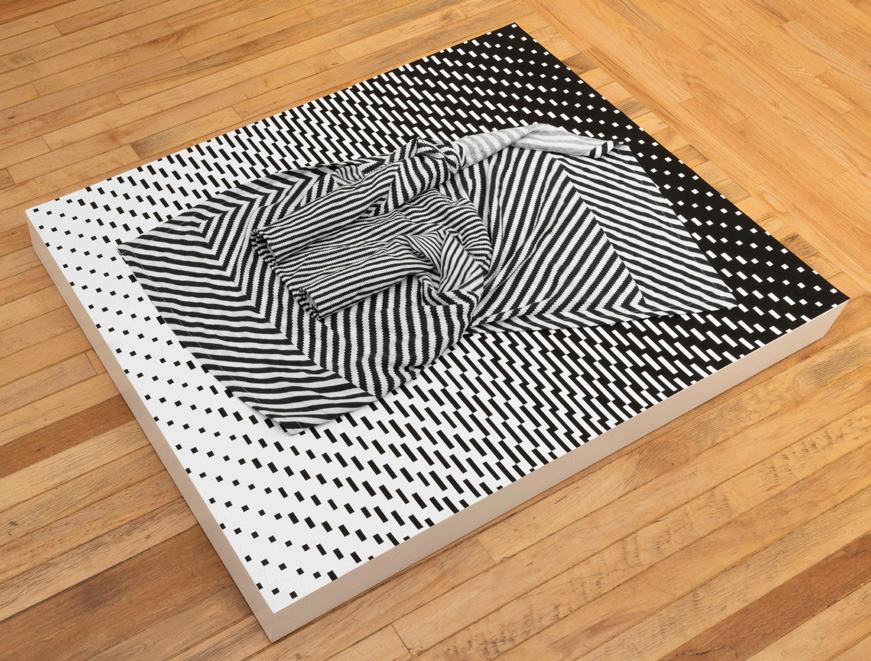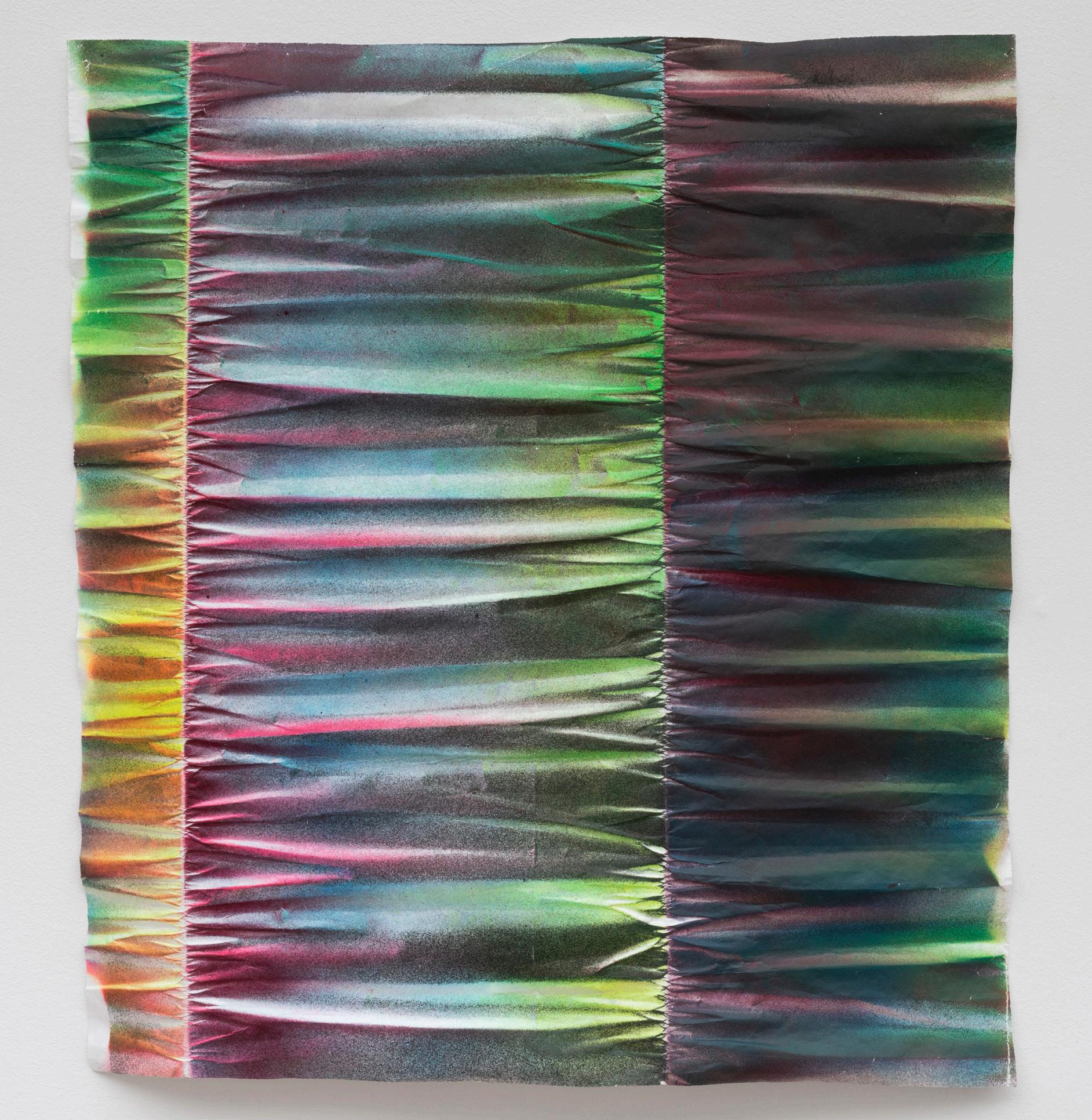
10 minute read
MARIANNE FAIRBANKS: IMAGE, STRUCTURE, FOLD

MARIANNE FAIRBANKS
Advertisement
MARIANNE FAIRBANKS: IMAGE, STRUCTURE, FOLD
JORDAN MARTINS
The first computer, some have argued, was a loom: Joseph Jacquard’s innovation of utilizing punch cards to automate complex weaving patterns in 1804 inadvertently imagined a model for how computational machines could function, channeling the already binary-driven logic of traditional weaving into an automated process. While there is ample debate about just how much credit should be given Jacquard in the history of computers, I find it nonetheless an intriguing hypothesis to ponder in relation to Marianne Fairbanks’s work. Her practice itself can be viewed as both a weaving and an un-weaving of the speculative connections between cloth and code. The innate tactility of fabric and the physical processes that produce it appear to be the very opposite of the disembodied attributes of computer processes and the virtuality of the digital realm. But this apparent contrast masks a deeper continuity between the respective logics of weaving and computing, namely,
the use of binary code as a catalyst for the production of surfaces. Much of Fairbanks recent work exhibited in A Deliberately Non-Straight Line points to and plays with this disjunct, employing subtle inversions and transgressions of both weaving and computing. In her work employing both processes, things that are normally hidden are made visible, and “inefficient” uses of technologies are embraced in an alchemical pursuit of new understandings of both codes and surfaces.
Code, like bacteria, is an ever present but invisible substance producing a variety of textures and surfaces around us. The magic of code is that non-coders like myself never had to see it, let alone think about it, it simply produces the things I see and think about in both physical spaces and virtual ones. As I write this, I don’t see 1’s and 0’s, I see letters of the Roman alphabet and menus and icons making various functions available. I can
Gradient Slippage, 2018, 35.5” x 26”, Cotton, polyester thread handwoven on TC-2 Loom

arrange tabs and other structures in ways that mimic analogue space. When I walk through various public and private spaces, I don’t ponder the shifting binary sequences that light up LED displays, indicate that it’s my turn to cross the street, or allow digital sound files to become transmitted across various
devices. These things don’t resemble the code that produces them, they are effects of it. It is equally easy to ignore the vast physical structures that in turn keep code flowing, such as the vast tracts of remote server farms that allow our nebulous ideas of the “cloud” to float. Even seemingly disembodied processes
such as “debugging” a program owe their name to a time when literal bugs were stuck within the punchcard apparatus of a midtwentieth century computer that may have more closely resembled Jacquard’s loom than a laptop or smartphone.
In weaving nomenclature, “structures” (plain, twill, satin, and innumerable variations) are the underlying codes that produce patterns, designs, or images. The terminology itself points again to the inherently physical processes by which woven textiles are produced, each seemingly flat sheet of fabric actually being a complex of sculpted structures building up to the design we see, this flat plane in turn wrapping itself around bodies and objects in space. As we see and wear these surfaces, we rarely think of the structure that produces them, the textures having taken on their own life much like the digital objects we encounter within screens. As they are now integrated into a computational processes, weaving structures exist as binary bitmaps within programs like Photoshop that mediate the design process as it becomes physical in the loom. This itself is a curious feedback loop within the loom-computer history, where the structures that first gave rise
to computational coding are themselves coded in programs as pattern fills to be applied as outputs to loom.
These intertwinings of loom/computer, structure/code, fabric/image and physical/virtual are often at the core of both Fairbanks’s process and content. In various works, from weavings to inkjet prints, image and structure have become conflated: in Twill Babies (2018) she places folds of linen printed with a black and white stripe patterns of various scales upon a flat inkjet printed satin gradation from light to dark. This piling up of structures-as-images-as-structures is both succinct and seemingly infinite in

Twill Babies, 2018, 6”X 36”x 46”, Ink jet print, digitally printed linen
the perceptual disorientation it produces. In a related diptych, Net Values 1 and Net Values 2, a similar piling-up of black and white weaving structures and folds is achieved through different means, this time making photo composites of actual woven fabrics, with the photographic images being printed as a uniformly woven surface; in other words, weavings become jpegs and the jpegs in turn become weavings, images become structures and structures in turn become images.
In these and other related pieces Fairbanks freely employs both highly controlled processes -- the Jacquard loom’s ability to operate with 2640 individually listed threads, or high resolution archival inkjet printing -- as well as blunt or inefficient processes such as cell phone snapshots, screen grabs or zooming in on image files well beyond their optimal resolution. Finely filigreed surfaces are therefore often shot through with rough pixels and plainly visible seams from these processes interacting. Rather than feeling like shortcuts or gaps production, I would argue that these jumps in resolution, logic, or platform are at the heart of what Fairbanks is investigating. As much as the increasing velocity at which code-based
systems infiltrate our daily life points to a kind of digitally-networked homogenization (Smart homes! Suggested friends! Streaming anything ever made!), we are also continually confronting the friction and hybridity of this network attempting to superimpose itself over uneven terrains. The small ruptures and transpositions in Fairbanks’ work, therefore, don’t amount to a hermeneutic study of fiber processes, rather, we could just as easily read them as an allegory for emailed jpegs that have been downloaded, opened, Photoshopped, re-saved, uploaded, printed on a t-shirt, and left on the wrong doorstep by the Amazon driver.
The manner in which Fairbanks continually transposes across the imagestructure divide, conflates front-back relationships, and invites eclectic joinings of material-logics also recalls the ludic methodologies of medieval alchemists who often took non-linear paths to achieve their transmutational goals: in order to transform base metals into gold, one most first mix in crushed bones, pass through a putrefaction phase, combine opposites, and distill out impurities. There was also a deeper idea that the alchemist must somehow transgress the “natural order” of

things in order to dislodge wisdom, a notion that is somewhat parallel to the way in which Fairbanks generates an ouroboros of an image eating its own structure, or resorts to “wrong” ways of capturing, compressing, and rendering images. As much as her gestures always feel entranced by the joy of looking at the apparatus of their own production, the sum of their parts leads beyond a mere reflexive illustration of process, as though a strange puzzle is being solved.

Other bodies of work shown in A Deliberately Non-Straight Line that don’t directly involve computers or looms nonetheless touch on similar questions and open up her exhibition to a wider territory of inquiry. Two untitled pieces adapt the logic of the traditional Japanese shibori technique whereby tightly folded cloth is dyed in a way to generate patterns based on how the folds were made. In these works, Fairbanks has appropriated housewrap, folded it in a manner similar to a collapsed venetian blind and applied multicolored blasts of spray paint (incidentally, housewrap is a visible surface during construction only to be sealed in as an underlying structure which acts as a barrier protecting the walls from rain seeping in). The shibori process at play here is one
Enter the Mesh, 2018, 10.5” x 7” wire, paint, tablet woven thread
of compression, again reminding us that digital concepts almost always refer back to physical ones. The combination of rigorous process and aleatory effects in these compressed surfaces reveals the same mode of working in the loom based works. In Enter the Mesh, she interlaces a length of tablet woven thread into a collapsed piece
Fuller Sampler, 2018, Size variable, metal blinds, paint, waxed kevlar

of found wire mesh, as though her thread were suturing up a fragment of broken Euclidean space in order to give it a new function. And in Fuller Sampler, an array of folded and twisted metal blinds - the same material used in Buckminster initial geodesic dome experiments at Black Mountain -- collectively form a shape
lexicon based on the particular balance of rigid tension and lightweight flexibility the blinds are engineered to hold.
One hundred years before Jacquard’s loom, Gottfried Leibniz is credited with inventing (in the West, at least) the binary arithmetic system that Jacquard’s punch
cards and future computer coding was built upon. Leibniz was intrigued by the idea that reducing down to the simplest possible system could facilitate even more complex operations to be carried out. Deleuze analyzes Leibniz’s broader philosophical and scientific framework within an expansive notion of The Baroque, understood not as a historical time period or style, rather, as an “operative function”, namely, the fold:
...a flexible or an elastic body still has cohering parts that form a fold, such that they are not separated into parts of parts but are rather divided into infinity in smaller and smaller folds that always retain a certain cohesion. Thus a continuous labyrinth is not a line dissolving into independent points, as flowing sand might dissolve into grains, but resembles a sheet of paper divided into infinite folds or separated into bending movements, each one determined by the consistent or conspiring surroundings.
Within folds, the outside of a surface can become the inside, distances can be shrunk, materials can be conjoined together in hybrid jumbles of form. Deleuze wants to understand and celebrate this operative
Fuller Sampler (detail), 2018, Size variable, metal blinds, paint, waxed kevlar

function as a constantly morphing set of surfaces, folding and unfolding into various arrangements, inverting one set of relationships for another as they reconfigure. I want to end by situating Fairbanks’s practice within this Deleuzian view of The Baroque, not because her practice happens to employ literal folds, rather, because we can see this operative function throughout her work. In A Deliberately Non-Straight Line she has folded her process back onto itself, revealing a new set of labyrinths to become lost in until the next ones form.
Jordan Martins is a Chicago based visual artist, curator, and educator. He received his MFA in visual arts from the Universidade Federal da Bahia in Salvador, Brazil in 2007, and is a lecturer at the School of the Art Institute of Chicago and North Park University. He is the executive director of Comfort Station, a multi-disciplinary art space in Chicago. Martins’s visual work is based in collage processes, including painting, photography, video and installation, and he has exhibited nationally and internationally. His work has been featured in exhibitions at The Mission, Evanston Art Center, LVL3, The Franklin, The Museu de Arte da Bahia, Goldfinch, and Experimental Sound Studio. He was a resident in the Chicago Artists Coalition’s HATCH program in 2013. Martins is co-director of Perto da Lá <> Close to There, a multi-disciplinary project with international artists in Salvador, Brazil and Chicago, USA.

Marianne Fairbanks is a visual artist, designer, curator and Assistant Professor of Design Studies at the University of Wisconsin-Madison. She received her MFA from the School of the Art Institute of Chicago and her BFA from the University of Michigan. Her work spans the fields of art, design, and social practice, seeking to chart new material and conceptual territories, to innovate solution-based design, and to foster fresh modes of cultural production.

